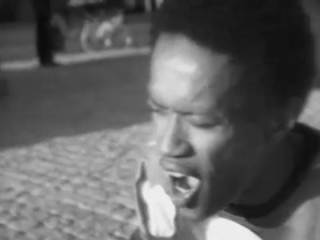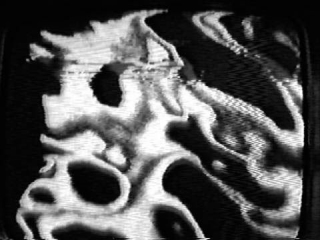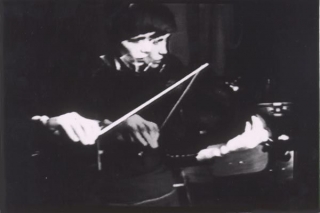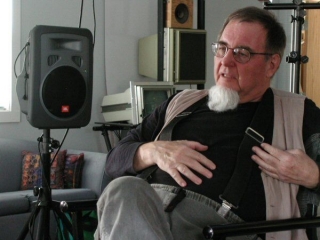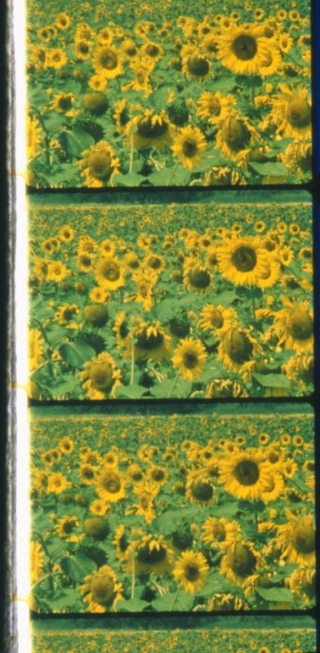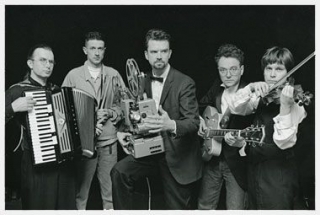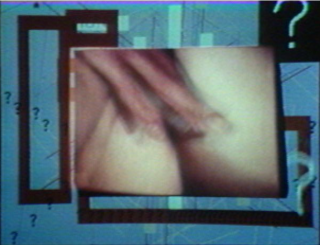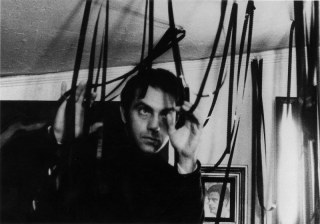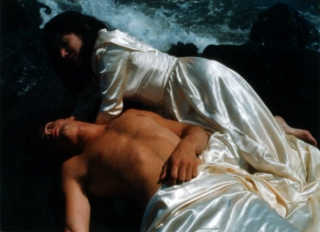Date: 5 March 2004 | Season: Vasulka Video
VASULKA VIDEO: PIONEERS OF ELECTRONIC ART
5—7 March 2004
London Candid Arts Trust & University of Westminster
An overview of Steina & Woody Vasulka’s video processing tools.
VCS3 (The Putney)
Designers: Peter Zinovieff, Tristram Cary and Dave Cockerell for Electronic Music Studios (EMS)
Year of conception: 1969
The VCS3, named for “voltage-controlled studio,” is best known by the name Putney in the United States. This analogue, duophonic synthesiser is equipped with a relatively small connection panel, compared to others of that time. It can control audio signals and their relationships to one another from the device itself. Integrated oscillators produce the repeated fluctuations of voltage that modulate the sounds. Conceived by atonal musical composers, the first version of the device did not have a keyboard.
Video Sequencer (Field Flip/Flop Switcher with Digital Control)
designer: George Brown
year of design: 1972
type of application: video
This sequencer allows the programmer to separate two video sources in a determined sequence. It controls, among other things, the alternation of the points of view of two cameras in real time on the same monitor. The sequence is controlled according to various parameters: the rhythm of the regular sweeping of the screen, sound pulsation, etc.
Horizontal Drift Variable Clock
Designer : George Brown and the Vasulkas
Year of conception: 1972
The Horizontal Drift Variable Clock is not in itself an instrument, but rather an external source of synchronisation that can control the horizontal displacement of a video image. By adding an oscillator with the capacity to go up to 15,000 cycles to the portable camera adapter (Sony Portapak), it is possible to control the voltage of the horizontal synchronisation signal. Typically, two cameras make up the system: one camera is hooked up to the normal vertical and horizontal synchronisation signal, while the other camera, whose image is being superimposed or keyed on the first, receives a different horizontal frequency. This will then result in the horizontal movement of the image towards the right or the left. The Vasulkas also used this technique to cause images to travel from one monitor to another in multi-monitor compositions.
Rutt/Etra Scan Processor
designers: Steve Rutt, Bill Etra, Louise Etra
year of design: 1973
marketed by: Rutt Electrophysics Corp. (New York, New York, United States)
type of application: video
This processor modulates the deflection line of the electromagnetic field of television images. On a normal screen, the synchronisation signals are controlled by electromagnets that guide the movement of an electromagnetic ray so as to scan the 525 screen lines. The Rutt-Etra monitor contains a system of electromagnets and a built-in synchronisation mechanism for processing the video signal. The modulations alter the field of raster lines, which are vertically deflected and appear to adopt the contours of objects.
Multikeyer
Designer: George Brown
Year of conception: 1973
This digital sequencer is controlling an analogue video keyer in real time. By way of the keying process, a chromatic value is removed from an image on which a motif will be added. In conjunction with the keyer, the Multikeyer enables six video sources to be merged and placed on different planes according to a pre-programmed sequence.
Programmer
Designer: George Brown
Year of conception: 1974
The only digital instrument in the Vasulka’s instrument collection before 1977, the Programmer can control the actions of a switcher or a keyer, both analog devices. It can store operation sequences in its memory and activate them at any chosen moment.
Digital Image Articulator
Designer: Jeffrey Schier and Woody Vasulka
Year of conception: 1978
This digitizer breaks the video image down pixel by pixel and reshapes the components in an environment governed by mathematical laws. The Digital Image Articulator generates effects of pixelation, manipulates the borders of an image, stretches the image vertically and horizontally, and duplicates it several times on the screen. It is also used to create sequences of complex geometric motifs based on algorithmic structures.
Date: 5 March 2004 | Season: Vasulka Video
PARTICIPATION
Friday 5 March 2004, at 7pm
London Candid Arts Trust
“Today it’s hard to imagine the excitement generated by the introduction of the Sony Portapak in 1969. Though not ‘portable’ by today’s standards, using half-inch reel-to-reel tapes (much like audiotapes, and only recording in black & white); the Portapak revolutionised a generation of artists’ understanding of image and time. In comparison to the simplest 16 mm sound sync set-up with crew, the Portapak finally made spontaneous roving sound and image documentation technically feasible and as well as affordable, and the attraction of instantaneous playback or closed circuit room situations proved irresistible in an atmosphere still reeling from the upheavals of the sixties.” —Arnold Dreyblatt
Steina & Woody Vasulka, Participation, 1971, b/w, sound, 62 min
Performers : Paul Ambrose, Ian Anderson, Billy Andrews, Gary Bartz, Tally Brown, Larry Chaplan, Don Cherry, Kevin Coe, Jackie Curtis, Candy Darling, Miles Davis, Jack De Johnette, Eric Emersion, Estelle !, Christmas Eve, Michael Enderson, Jimi Hendrix, Stephen Holt, Keith Jarret, Jay Johnson, Aunt Josie, Agosto Machado, Taylor Mead, Buddy Miles, Geri Miller, Mario Montez, Airto Moreira, Paul Morrissey, Ondine, Rita Redd, Al Sayegh, Silva, Ekathrina Sobechanskaya, Steve Stanwick, Steina, Artchie Strips, David Susskind, Tinkerbelle, Jethro Tull, Richard Weinstock, Holly Woodlawn.
PROGRAMME NOTES
PARTICIPATION
Friday 5 March 2004, at 7pm
London Candid Arts Trust
PARTICIPATION
Steina & Woody Vasulka, 1971, b/w, sound, 62 min
After acquiring their first video portapak, the Vasulkas, like other early video practitioners, took their camera to the streets to document the counterculture life in the late 1960s and early 1970s. Through their newly arrived eyes, the alternative movements of American culture presented unlimited possibilities. They later wrote of this time: “We were interested in certain decadent aspects of America, the phenomena of the time – underground rock and roll, homosexual theatre, and the rest of illegitimate culture. In the same way, we were curious about more puritanical concepts of art inspired by Marshall McLuhan and Buckminster Fuller. It seemed a strange and unified front – against the establishment.”
In Participation the Vasulkas present vignettes of marginal culture – rock concerts, gay theatre, and impromptu street theatre. These tapes embody the originality and spontaneity that characterise early experiments with video: Don Cherry eloquently playing his trumpet in Washington Square Park, Jimi Hendrix and Jethro Tull performing at the Fillmore East, Andy Warhol’s gang arguing vehemently on the David Susskind Show about whether or not they are being exploited, and transvestites acting impromptu skits in makeshift theatres.
Participation evokes not only the utopian moment of the counterculture at a time of political upheaval but also the utopian moment of the video medium, when a sense of immediacy seemed to imbue every shot – a time when video practitioners like the Vasulkas were excitedly discovering the possibilities of electronic imaging.
Back to top
Date: 6 March 2004 | Season: Vasulka Video
VASULKA VIDEO: VIDEO GALLERY
Saturday 6 March 2004, 11am—5pm
London Candid Arts Trust
Continuous projection at Candid Arts Trust. Screening at approximately 11am and 2pm.
Steina & Woody Vasulka, Swan Lake, 1971, b/w, sound, 7 min
Steina & Woody Vasulka, Sketches: Red Roses, 1970, b/w, sound, 5 min
Steina & Woody Vasulka, Sketches: Let It Be, 1970, b/w, sound, 4 min
Steina & Woody Vasulka, Sketches: The Kiss, 1970, b/w, sound, 2 min
Steina & Woody Vasulka, Sketches: Charles’ Story, 1970, b/w, sound, 5 min
Steina & Woody Vasulka, Sketches: Alfons, 1970, b/w, sound, 3 min
Steina & Woody Vasulka, Sketches: Thierry, 1970, b/w, sound, 2 min
Steina & Woody Vasulka, Sketches: Gun Dance, 1970, b/w, sound, 3 min
The Vasulkas capture the counter-cultural spirit of the era in a series of performances by Larry, Jackie Curtis, Steina, Charles Hayworth, Helen Wong, Alfons Schilling, Thierry Benizeau and Daniel Nagrin. These ‘sketches’ also reveal the Vasulkas’ early experiments with electronic image manipulation.
Steina & Woody Vasulka, Studies: Interface, 1970, b/w, sound, 4 min
Performer: Charles Hayworth. Audio: Gino Piserchio.
Steina & Woody Vasulka, Studies: Discs, 1970, b/w, sound, 5.5 min
A circular image of a reel is set in a rapid motion by a difference in horizontal camera drives. The image repetition results from a time delay produced by re-entering the signal into the system: a visual echo. Sounds result from a video signal interfaced with a sound synthesiser.
Steina & Woody Vasulka, Studies: Calligrams, 1970, b/w, sound, 3.5 min
A re-scan camera is pointed at the television monitor displaying a pre-recorded tape. A misalignment of the horizontal hold causes a vertical multiplication of the image.
Steina & Woody Vasulka, Studies: Tissues, 1970, b/w, sound, 1.5 min
Various camera images are randomly inserted onto a pre-recorded tape. These forced edits become the source of abrupt voltage changes in the audio when looped through a sound synthesizer.
Steina & Woody Vasulka, Studies: Descends, 1970, b/w, sound, 4 min
Steina & Woody Vasulka, Studies: Decay I, 1970, colour, sound, 2 min
Dual Colorizer: Eric Siegel
A face, pre-recorded on a videotape, is manually forwarded on the playback to produce image decay.
Steina & Woody Vasulka, Studies: Decay II, 1970, colour, sound, 1 min
Dual Colorizer: Eric Siegel
An audio generated shape is pre-recorded on a videotape which is then manually moved on the video playback to produce image decay.
Steina & Woody Vasulka, Distant Activities, 1972, colour, sound, 5 min
Dual Colorizer: Eric Siegel
The protagonist is a video feedback, processed and controlled through a video keyer. Sound is from video signals interfaced with an audio synthesiser.
Date: 6 March 2004 | Season: Vasulka Video
VASULKA VIDEO: PERFORMANCE
Saturday 6 March 2004, at 7:30pm
London University of Westminster
Steina presents a live adaptation of her seminal tape Violin Power, using MIDI violin and customised software to process the video image in real time. Plus a screening of Orbital Obsessions, a multi-layered studio performance/exploration of reshaped video space.
Steina, Violin Power: The Performance, 1992-present
Steina, Violin Power, 1970-78, b/w, sound, 10 mins
Steina, Orbital Obsessions, 1975-77/78, b/w, sound, 25 mins
PROGRAMME NOTES
VASULKA VIDEO: PERFORMANCE
Saturday 6 March 2004, at 7:30pm
London University of Westminster
VIOLIN POWER: THE PERFORMANCE
Steina, 1992-present, live performance
“In 1991, after having experimentally interfaced my acoustic violin with a variable speed video cassette player, I bought a MIDI violin and a Pioneer Disk Player. Interfacing these instruments with a computer gave me an instant access to any frame of video on the disk as well as access to fast/slow and forward/backward movements. The initial software was written by Russ Gritzo and further developed and improved by Bill Heckel. Violin Power is a ongoing continuous project with an ever increasing ‘repertoire.’ So far I have made five videodisks and I change the program for every performance.” (Steina)
The ZETA Violin is a five-stringed electric violin with a MIDI output. The assignment, at the moment, is that stops on A and E string point to frame locations on the disk. The D and G strings control speed and direction and the C string is a master controller assigned to address segments on the disks. In another programming scheme, the C string controls which upper strings get assigned their function, as Steina experiments to make the performance more musically interesting.
“Steina’s project of manipulating and fusing the “real” and the electronic, sound and image, has in recent years taken the form of performances in which she returns to her roots as a musician. Transposing the strategies of her early Violin Power to a theatrical scale, Steina performs on a violin that digitally generates and controls a progression of projected images.” (Mondavi Arts Center)
VIOLIN POWER
Steina, 1970-78, b/w, sound, 10 mins
The first excerpt investigates the impact of varying pitches on the speed of the image. Steina’s body is invaded by a sort of double-exposure that quivers like the vibrato produced by a violin bow. In another sequence, Steina adds further components to an already complex interface. The sound modulations of the violin cause the viewpoints of two parallel cameras to alternate. Steina is first seen from behind, and then the bow’s movement seems to deflect the signal and a keyed-in image of Steina from the front appears. This effect is generated by the combined use of a keyer and an audio synthesiser (Harald Bode’s Phase Shifter) in closed circuit with the two cameras. Other excerpts feature effects generated by the Scan Processor developed by Steve Rutt and Bill Etra. The sound waves seem to cause ripples in the image’s surface, while the bow’s friction on the strings results in textured visual effects that evoke the violin’s timbre. Finally, the representation of the performing musician, the sounds produced, and the modulations in the video signal converge into a single luminous entity. The Vasulkas are deeply intrigued by the interface between audiotape and videotape; indeed, this interface is the focus of such pieces as Noisefields (1974) and Voice Windows (1986). Violin Power adds an additional dimension to this dialectic research by simultaneously showing the gestation of images, their mediation by instruments (violins, synthesizers), and the moment when these images crystallise on the monitor.
ORBITAL OBSESSIONS
Steinal, 1975-77/78, b/w, sound, 25 mins
Orbital Obsessions includes excerpts from Signifying Nothing (1975), Sound and Fury (1975), Switch! Monitor! Drift! (1976) and Snowed Tapes (1977). In these pieces, Steina focuses on time, space, and movement, and the means by which the mechanical can inform and engage with electronic media. Steina writes: “Ordinarily the camera view is associated with a human view point, paying attention to the human conditions around the camera. In this series the camera conforms to a mechanised decision-making of instruments… I am also paying attention to time accumulation, in a mix of real time with time inherited from each previous generation of pre-recorded and then re-taped segments.”
Back to top
Date: 7 March 2004 | Season: Vasulka Video
VASULKA VIDEO: LECTURE
Sunday 7 March 2004, at 3pm
London Candid Arts Trust
Woody Vasulka: Lecture on Sound and Image Relationships in Early Video Art
Initially, they identified two properties peculiar to video. Both audio and video signals are composed of electronic waveforms. Since sound can be used to generate video, and vice versa, one of the first pieces of equipment the Vasulkas bought was an audio synthesiser. Many of their tapes illustrate this relationship – one type of signal determines the form of the other. Their second interest entailed construction of the video frame. Because timing pulses control the stability of the video raster to create the “normal” image we are accustomed to, viewers rarely realise – unless their TV set breaks down – that the video signal is actually a frameless continuum. This fact, discovered accidentally, fascinated the Vasulkas.
“At that time, I was totally obsessed with this idea that there was no single frame anymore. I come from the movies, where the frame was extremely rigid, and I understood that electronic material has no limitation within its existence. It only has limitation when it reaches the screen because the screen itself is a rigid time structure.” —Woody Vasulka in Afterimage, 1983
PROGRAMME NOTES
VASULKA VIDEO: LECTURE
Sunday 7 March 2004, at 3pm
London Candid Arts Trust
WOODY VASULKA
Since the mid-1970s, Woody Vasulka’s work has focused on a rich articulation of the syntactical potential of electronic imaging. After producing a pioneering body of tapes in collaboration with Steina in the early 1970s, he has since undertaken a sophisticated exploration of the narrative and metaphorical meaning of technological images. Vasulka’s development of an expressive image-language has evolved from a rigorous deconstruction of the materiality of the electronic signal, through experiments with new technologies of digital manipulation, to the application of these imaging codes to narrative strategies.
The culmination of this investigation, Art of Memory (1987), is one of the major works in video. In this lushly textured, haunting essay, Vasulka applies a highly evolved imaging grammar to a metaphorical discourse of collective memory, history, and the meaning of recorded images – envisioned as a spectacular memory-theatre inscribed upon the landscape of the American Southwest.
In his early investigations of the vocabulary of such devices as the Digital Image Articulator, Vasulka emphasised the dialogue between artist and machine, as manifested in real-time creativity and process-oriented experimentation. Through digital manipulation, he continues to explore the malleability and objectification of the electronic image as a means of rendering a complex inventory of rhetorical devices. With the fantastical ‘electronic opera’ The Commission (1983), Vasulka began to apply these codes to the development of narrative and metaphorical strategies, an inquiry that has dominated his later work.
Woody Vasulka was born in Brno, Czechoslovakia in 1937. He studied at the School of Industrial Engineering in Brno and the Academy of Performing Arts Faculty of Film and Television in Prague. With Steina, he has won numerous awards and grants; their collaborative works have been exhibited internationally. His individual works have been shown in numerous exhibitions, at festivals and institutions including the International Center of Photography, New York; Los Angeles Contemporary Exhibitions (LACE); Carnegie Museum of Art, Pittsburgh; and the Whitney Museum of American Art Biennial, New York. Woody Vasulka lives in Santa Fe, New Mexico.
Back to top
Date: 14 March 2004 | Season: Miscellaneous
SPRING WITH ROSE LOWDER
Sunday 14 March 2004, at 2pm
London Tate Britain Clore Auditorium
Rose Lowder will present a selection of her films from the 1970s to the present day. Lowder’s ecological style portrays nature in a unique manner, with each film meticulously constructed by individually composing and exposing every single frame. In projection, condensed clusters of images form a retinal collage of spatial and temporal impressions. This programme mixes early works such as Parcelle (1979) and Les Tournesols (1982) with selections from the ongoing series of Bouquets (1994-present) and other recent films shown for the first time in the UK.
Rose Lowder, Champ Provençale, 1979, colour, silent, 9 min
Rose Lowder, Parcelle, 1979, colour, silent, 3 min
Rose Lowder, Les Tournesols, 1982, colour, silent, 3 min
Rose Lowder, Les Tournesols Colorés, 1983, colour, silent, 3 min
Rose Lowder, Roulement, Rouerie, Aubage, 1978) b/w & colour, silent, 15 min
Rose Lowder, Quiproquo, 1992, colour, sound, 13 min
Rose Lowder, Les Coquelicots, 2000, colour, silent, 3 min (18fps)
Rose Lowder, Bouquets 21-27, 2001-03, colour, silent, 10 min (18fps)
After studying painting and sculpture in artists’ studios and art school in Lima and London, Rose Lowder pursued her artistic practice while working as an editor in the film industry. From 1977 onwards, her research concentrated on the visual aspect of the cinematographic process. A co-founder of Les Archives du film expérimental d’Avignon (AFEA), a film and document collection, Lowder is currently associate professor at the Sorbonne.
PROGRAMME NOTES
SPRING WITH ROSE LOWDER
Sunday 14 March 2004, at 2pm
London Tate Britain Clore Auditorium
“I did not have a preconceived idea of a method for making my films. It is only in trying, with the available means, to solve the problems that occurred that progressively from one film to another, that I found different ways to proceed. Having practised various fine arts for a long time, I began by using the resources belonging to those means of expression in order to explore various ways one can establish relationships between aspects of reality and the essential qualities of the film image seen projected on the screen.
“Like many filmmakers working outside the norms of traditional production, I tested, without intervening physically in the filmed (or not filmed) reality, a variety of procedures that form the substance constituting the film image. This way of working draws attention to the procedure by which the image is produced to the extent that the process of fabrication plays a greater part in the meaning the work intends to convey.
“The concentration on the rendering of the images installs a less direct relationship between what is considered the usual appearance of reality and the film’s images, which leads to changes in how one conceives the link between observed or lived reality, and what is made evident on the screen during the projection of the finished film.”
Text by Rose Lowder excerpted from the booklet that will accompany “A Bouquet of Images”, a forthcoming Re:Voir video release of selected films.
Back to top
Date: 21 March 2004 | Season: Miscellaneous
DAVID LEISTER: NATURE BOY
Sunday 21 March 2004, at 2pm
London Tate Britain Clore Auditorium
A pastoral projection by David Leister, centred around his 16mm found footage hybrid Nature Boy (1990), and films from his extraordinary and eclectic collection. Featuring glimpses through the back gardens of British amateur movie makers, an instructional film on flower arranging, and a Cine Society film with poetic commentary on the passing of the seasons. Plus surprise films and a celebration of Eden Ahbez’ classic song “Nature Boy”, interpreted in many strange and wonderful ways.
Arranging Flowers, date and filmmakers unknown, 12 min
A film made by and/or for a women’s group demonstrating … the arranging of flowers! With commentary and tasteful music. (Kino Club Archives)
Gregory Kurcewicz, The Past is History, Tomorrow is a Mystery, Today is a Gift, That’s Why it’s Called The Present, 2004, 3 min
Blown up from super 8 original, flower arranging of the experimental kind.
Safety First, date and filmmaker unknown, 10 min
An educational film warning of the dangers of stinging plants using time lapse cinematography, with an equally time lapsed commentary. (Kino Club Archives)
Sophie Lascelles, Dig, 2002, 3 min excerpt of continuous loop
Created for the exhibition Diversion at the Museum of Garden History
Sophie Lascelles, Till, 2003, 3 min excerpt of continuous loop
Created for Great Piece of Turf, at Danielle Arnaud Gallery
My Second Love and Garden Girl, anonymous amateur films, date unknown, 6 min
Two clips from amateur filmmakers; the first a close up look at flowers in a backyard garden, and the second being an affectionate portrait of a young woman playing to the camera. (Kino Club Archives)
William English, Displaced, 2000, 15 min
“the more I thought of it later the more it seemed strong as an image of alienation, emptiness and just strangeness, those shots of colour on the surface somehow of those trailers, the gloss of them just being there, and the tents, the kind of mystery and (un-heavy-handed) alienation at the same time without some spurious meanings intercut, they had a necessary time of their own to impart their effect(s)… no anecdotal copouts; the whole thing gained rather than lost afterwards which is always a good sign with films I think” —Peter Gidal, August 2000
David Leister, Nature Boy, 1990, 14 min
Nature Boy is a film about making things grow. Found footage is grafted on to ‘shot to match’ film to produce a successful hybrid of new and old. In this way of ‘recycling’ imagery, Nature Boy is truly an environmentally friendly film. Aleks Kolkowski (violin) and Ian Hill (accordion) specially prepared the original music score from Kino Club sessions. Note: for maximum enjoyment a number 138 green gel should be placed over the lens during projection.
The Changing Scene, anonymous amateur film, early 1960s, 13 min
A rare 16mm amateur sound film with ‘live’ commentary from T. B. Sansom giving his candid and charming observations on the passing of seasons in and around Edinburgh and the north of England in the early 60s. (Kino Club Archives)
“Nature Boy: David Leister” curated by Mark Webber for LUX and Tate Britain. Programme composed by David Leister. Thanks to Ben Cook for the musical interludes.
Date: 30 March 2004 | Season: LUX Salon | Tags: London Lesbian & Gay Film Festival
LUX SALON: BARBARA HAMMER
Tuesday 30 March 2004, at 7:30pm
London LUX
Barbara Hammer, is an internationally recognised film artist who has made over eighty films and videos, and is considered a pioneer of lesbian-feminist experimental cinema.
Barbara Hammer, Dyketactics, 1974, colour, sound, 4 min
Barbara Hammer, Multiple Orgasm, 1977, colour, sound, 6 min
Barbara Hammer, Double Strength, 1978, colour, sound, 16 min
Barbara Hammer, Our Trip, 1980, colour, sound, 4 min
Barbara Hammer, Sync Touch, 1981, colour, sound, 10 min
Barbara Hammer, No No Nooky T.V., 1987, b/w & colour, sound, 12 min
“To discover and uncover the invisible images and material in photography, film and video has been my pursuit for over twenty-five years as a pioneer lesbian artist. I have made over seventy-seven film and videos since 1972. All my work is about revealing, showing, expressing, uncovering that which has not been seen before. I try to give voice and image to those who have been denied personal expression. I continue to be involved in formal structure determined by the content of the material. Over the years my films and videos have evolved to dense referential montages characterised by a challenging montage/collage of image and audio. I seek to empower the viewing audience to “make their own film” by working in a non-linear, metaphoric and fragmented manner. It is a political act to work and speak as a lesbian artist in the dominant art world and to speak as an avant-garde artist to a lesbian and gay audience. My presence and voice address both issues of homophobia as well as the need for an emerging community to explore a new imagination.” (Barbara Hammer)
PROGRAMME NOTES
LUX SALON: BARBARA HAMMER
Tuesday 30 March 2004, at 7:30pm
London LUX
DYKETACTICS
Barbara Hammer, 1974, colour, sound, 4 min
The first lesbian lovemaking film to be made by a lesbian filmmaker. Sensual, evocative montage of 110 images selected for their representation of ‘touching’. In the words of the filmmaker, “I wanted to make a lesbian commercial.”
“The images are varied and very quickly presented in the early part of the film, introducing the characters, if you will. The second half of the film slows down measurably and all of a sudden I found myself holding my breath as I watched the images of love-making sensually and artistically captured.” (Elizabeth Lay, Plexus)
MULTIPLE ORGASM
Barbara Hammer, 1977, colour, sound, 6 min
A sensual, explicit film that says just what it is, plus visual overlays of erotic rock and cave formations.
DOUBLE STRENGTH
Barbara Hammer, 1978, colour, sound, 16 min
“One of Barbara’s most beautiful films on personal relationships made with trapeze artist Terry Sendgraff, shot swinging in the nude from various angles. The image poetry carries us through the duration of a relationship: its intensely erotic beginnings, its sense of serenity, its playfulness and comedy, and its closure, the alienation, pain, anger, and loss of contact. The death of the body, a theme tenderly interwoven into the ageless strength and agility of Terry Sendgraff’s body, becomes the death of a relationship, a closing out, a blanking out, a leaving of the body behind. The body becomes a source of life. Its movement, grace, pain, and happiness are contrasted with the inertness of things and the stillness of photos that merely document the brief passage of light.” (Jacqueline Zita, Jumpcut)
OUR TRIP
Barbara Hammer, 1980, colour, sound, 4 min
“Feminist filmmaker Barbara Hammer has celebrated her recent trip to Peru with her friend Corky Wick through a diaristic animation of photographs they took during their travels. Landscapes and portraits are given growing patterns of framing and texture with magic markers and tempera paint, expressing the richly evocative folk art of the Incan people they saw as we hear their native music resonate on the soundtrack.” (Anthony Reveaux)
SYNC TOUCH
Barbara Hammer, 1981, colour, sound, 10 min
“At the opening we are listening to an ‘expert’ speaking – someone who knows about touch and erogenous zones, about the erotic – yet the emphasis is on her ‘knowing’ and what she knows ‘about’ rather than on her ‘experiencing.’ Hammer undercuts the monologue with intense and extraordinary close-ups of areas of the woman’s face and neck, her teeth and lips, her ears. The viewer becomes so absorbed in the details of this closeness, the closeness of a lover seeing the face of her friend, that the words become lost in feeling and experiencing the closeness itself. The other way this works is to make the viewer want to touch, to become involved for, as the speaker says, touch precedes sight in the new-born child, and sight becomes a connection between the actual touch and understanding what it means.” (Cath Dunsford, Alternative Cinema)
NO NO NOOKY T.V.
Barbara Hammer, 1987, b/w & colour, sound, 12 min
Using a 16mm Bolex and Amiga computer, Hammer creates a witty and stunning film about how women view their sexuality versus the way male images of women and sex are perceived. The impact of technology on sexuality and emotion and the sensual self is explored through computer language juxtaposed with everyday colloquial language of sex. No No Nooky T.V. confronts the feminist controversy around sexuality with electronic language, pixels and interface. Even the monitor is eroticised in this film/video hybrid that points fun at romance, sexuality, and love in our post-industrial age.
Presented in association with the London Lesbian & Gay Film Festival, with thanks to Selina Robertson.
Back to top
Date: 16 April 2004 | Season: Gregory Markopoulos 2004 | Tags: Gregory Markopoulos, Markopoulos
GREGORY J. MARKOPOULOS
16-21 April 2004
London National Film Theatre
GREGORY J. MARKOPOULOS
Towards The Temenos: Myth, Portraiture and Films of Place
Gregory Markopoulos was the archetypal personal filmmaker: an accomplished technician, masterful editor and consummate perfectionist, who created great works of art with a minimum of means. A contemporary of Kenneth Anger, Stan Brakhage and Maya Deren, he was a major figure of the New American Cinema, the post-war movement that developed a new, visionary approach to film.
Markopoulos regarded cinema as “a supreme art in a dark age”. His films illuminate literature, portraiture and architecture, shaping a modern mythology that owes more to European traditions of art-making than the Hollywood culture of commercial cinema. As a formal innovator, he developed rapid editing techniques which cut through time and space, shaping new narrative forms through a “fusion of classic montage with a more abstract system”.
Such a progressive approach to cinema, and the belief in its ability to convey thought and emotion, was grounded in an appreciation of early masters such as von Stroheim and von Sternberg, and a strong, personal commitment to developing the medium beyond its basic use in the narrative sense. Driven by a purity of vision that transcended cinematic conventions, Markopoulos’ sensual and poetic films shimmer with colour and resonate with passion.
This NFT retrospective, centred on key works of the 60s, is the first opportunity in decades to see a selection of Markopoulos’ work in the UK, and shows the filmmaker during his most visible and influential period. After moving to Europe in 1967, he withdrew all of his films from distribution, citing frustration with inadequate projection facilities and unappreciative audiences. Many subsequent films were completed but never shown, as Markopoulos conceived of the Temenos as the ideal site for a spectator’s quest. In this chosen place, the films may elevate the audience’s sense of time while emotionally and physically connecting them to the mythic themes and locations.
He died in 1992, shortly after final editing of the monumental Eniaios, which comprises of 22 cycles totalling over 80 hours of viewing time. This epic work combines radically re-edited versions of all his previous works, and many unseen films, into a single, unified whole. Filmmaker Robert Beavers has established the Temenos Association for the preservation, study and promotion of Markopoulos’ total vision, including his films, journals, letters and collected writings. This NFT season precedes the premiere of the first cycles of Eniaios, to be projected outdoors in the Greek countryside in late June.
www.the-temenos.org
LITERATURE AND MYTH: Fri 16 & Sun 18 Apr 2004
Swain and Twice a Man, two interpretations of classic literature that show a unique command of film language.
FILMS OF PLACE: Sat 17 & Mon 19 Apr 2004
Ming Green, Sorrows and Gammelion. Elegant portraits of architecture and interiors.
THE ILLIAC PASSION: Sat 17 & Tue 20 Apr 2004
The Illiac Passion, an underground interpretation of ‘Prometheus Unbound’, plus Bliss, a study of a small Greek church.
PORTRAITURE: Sun 18 & Wed 21 Apr 2004
Galaxie and Saint Actaeon. Portraits of the artistic community forming a who’s who of the 60s art world.
Markopoulos season curated by Mark Webber for NFT and LUX, in collaboration with Temenos Association. Supported by Greece In London 2004 / The Hellenic Foundation for Culture, UK. With thanks to Robert Beavers, Dr Victoria Solomides and Österreichisches Filmmuseum.
Back to top
Date: 16 April 2004 | Season: Gregory Markopoulos 2004 | Tags: Gregory Markopoulos, Markopoulos
LITERATURE AND MYTH
Friday 16 April 2004, at 6.20pm
London National Film Theatre NFT2
Two contemporary, personal interpretations of classical literature. In Swain, an early psychodrama based on Nathaniel Hawthorne’s novel ‘Fanshawe’, a young man flees from a woman who represents an oppressive sexual identity. Twice A Man is a modern adaptation of the myth of Hippolytus, in which a chaste youth rejects the advances of his mother and is saved from death by a caring physician. This film demonstrates a great stylistic leap as Markopoulos introduces single-frame montage and a more elliptical narrative process.
Gregory Markopoulos, Swain, USA, 1950, 25 min
Gregory Markopoulos, Twice A Man, USA, 1963, 49 min
The programme will be introduced by Robert Beavers, filmmaker and director of Temenos Inc.
Also Screening: Sunday 18 April 2004, at 8.40pm, NFT2
PROGRAMME NOTES
LITERATURE AND MYTH
Friday 16 April 2004, at 6.20pm
London National Film Theatre NFT2
SWAIN
Gregory Markopoulos, USA, 1950, 16mm, colour, sound, 25 min
TWICE A MAN
Gregory Markopoulos, USA, 1963, 16mm, colour, sound, 49 min
The work of Gregory Markopoulos occupies a unique position in the history of film. He is widely regarded as one of the masters of the cinematic art, yet since he departed the United States in 1967 his films were almost impossible to see. As a result of his need for total control over the presentation of his vision, he increasingly withdrew himself and his films from the film community he had been so actively involved in up to that point.
In recent years the films of Markopoulos have been gradually reintroduced to the viewing public and have been honoured at major museums and festivals, including retrospectives at the American Centre (Paris 1995), The Whitney Museum of American Art (New York 1996), Pacific Film Archive (San Francisco 1997) The Film Society of Lincoln Centre (New York 2003) and Harvard Film Archive (2003). In May 2003, Robert Beavers and Simon Field presented a screening of Markopoulos films at the Goethe Institute, Athens, to an audience exceeding 350 people, and in June 2004, Temenos Inc. will resume the summer screening programme at the outdoor site in Lyssaraia.
This National Film Theatre season is the first time that so many of the films of Markopoulos have been shown in England on such a scale. Since he withdrew his films from exhibition in the early 1970s, they have been virtually impossible to see in the UK. This high-profile event will also act as a precursor to the resumption of outdoor Temenos projections at a remote site near Arcadia in the Peloponnese in June 2004, where restored films from the epic Eniaios cycle will be presented in public the first time. For three consecutive nights, screenings will take place from 10pm to 4am in the place chosen by Markopoulos as the ideal site for a spectator’s quest, in which his films may elevate the spectators’ sense of time while emotionally and physically connecting them to the mythic themes and locations.
Markopoulos was born in Toledo, Ohio, in 1928. He was the son of Greek parents and was encouraged to speak their native language up until he entered an English speaking school. In 1940 he was given an 8mm camera and made one of his first films A Christmas Carol (1940). That film survives but others from 1940-45 were destroyed by the filmmaker. After studying film at the University of Southern California and assisting Curtis Harrington on Fragment of Seeking (1946), he made the film Psyche (1947). With Lysis and Charmides (both 1948), it formed a trilogy titled Du sang de la volupté et de la mort (1947-48), an early cinematic representation of homosexual love. In the following years he made a number of films, including Swain and Flowers of Asphalt (both 1951), in which he refined his technique.
‘Swain is an evocation in gentle images and visual symbols of a subconscious rejection of the stereotyped masculine role that society and women insist upon. This rejection takes the form of an escape: a flight into fantasy from what is visually conceived as crude, repelling sexuality into the purity of creative activity, of nature, and of the individual personality left inviolate’ (Donald Weinstein)
In 1954 he destroyed all of his journals and travelled to Greece to start anew. He developed a scenario for the film Serenity (1955-60) and spent several years travelling between Greece and the USA to raise funding. The film was shot in 1958 using predominantly untrained Greek actors. In 1960 he edited the film and composed a soundtrack using simultaneous English, Greek, German and Russian narration. It was premiered as an unfinished work print in October 1961, but after three screenings Markopoulos was forced to return the film to the production company in order to receive his director’s fee. He never saw his film again, despite employing an attorney try to get it back in 1963. The same year he published Quest for Serenity (Journal of a Film-maker) detailing the film’s troubled eight year long history.
Meanwhile, since 1961, Markopoulos had been working on Twice A Man (1963) based on Markopoulos’s modernist reworking of the myth of Hippolytus, in which a chaste youth rejects the incestuous advances of his mother, Phaedre, and is saved from death by a caring physician. For Markopoulos, this short feature represented his most elaborate attempt to date to create ‘a new narrative form through the fusion of the classic montage technique with a more abstract system.’ The film opens with an extended passage of black leader and the sound of falling rain before plunging into a dazzlingly complex array of interwoven single frames and clusters of images to elaborate a tale of artistic rebirth.
‘The protagonist grapples with past, present, and future while pursuing Eros and creativity… Paul encounters a labyrinth of memories, echoing with colour and pierced by shards of syncopated speech that form a portion of the film’s extraordinary soundtrack.’ (Kristin M. Jones)
The soundtrack is also innovative, as Markopoulos fragments words and phases by manipulating the audio tape. It remains a major work of mythopoeic cinema.
(Mark Webber)
Back to top

